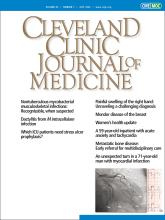A 43-year-old woman presented to the outpatient breast clinic with a 2-week history of pain and skin tightness over the right breast. She had no history of breast-related surgeries or trauma and was not on any regular medication. Physical examination revealed a subcutaneous cord-like, fibrous, tender lesion running diagonally from the upper outer quadrant of the right breast to the right flank, causing skin retraction and a groove over the outer half of the right breast when the right arm was stretched upward (Figure 1).
Anterolateral thoracoabdominal wall showing the vertical cord and groove (arrow) on the outer half of the right breast while stretching the right arm upward.
Doppler ultrasonography revealed a noncompressible, dilated, subcutaneous vein without flow, supporting the diagnosis of Mondor disease of the breast, which commonly presents superficially in the lateral part of the breast. Mammography revealed no abnormality. The lesion and pain resolved within 4 weeks of presentation without medication, and 6-months follow-up showed no recurrence (Figure 2).
The skin lesion and tenderness resolved within 4 weeks, and relapse had not occurred at 6-month follow-up.
MONDOR DISEASE OF THE BREAST
Mondor disease of the breast is a benign clinical condition characterized by thrombophlebitis of the superficial veins of the anterolateral thoracoabdominal wall, occurring most commonly in women in the third to fifth decades,1,2 with incidence ranging from 0.08% to 0.94% in breast studies in Greece, Ghana, and China.2–5 Diagnosis is usually based on history and physical examination and can be ultrasonographically confirmed.1 In 45% of cases, primary Mondor disease of the chest wall is idiopathic. Secondary Mondor disease involves predisposing or underlying factors, the most common causes being traumatic (22%) and iatrogenic (20%).1
Although association with breast cancer is less frequent (5%),1 Mondor disease can occasionally be caused by breast cancer (11.7%)6 and does not rule out the presence of a tumor. Therefore, a thorough breast evaluation including diagnostic imaging is recommended.1,6,7 In addition to local manifestations, concomitant symptoms such as fever and malaise should be considered to rule out the possibility of underlying systemic inflammatory disease.1,8
Mondor disease of the breast is typically a self-limiting condition, with spontaneous resolution in 4 to 8 weeks.1 Pain may be managed with anti-inflammatory and analgesic drugs.1,8 It is important for the clinician to recognize this condition, provide reassurance, and avoid unnecessary investigation.
DISCLOSURES
The author reports no relevant financial relationships which, in the context of his contributions, could be perceived as a potential conflict of interest.
- Copyright © 2022 The Cleveland Clinic Foundation. All Rights Reserved.








